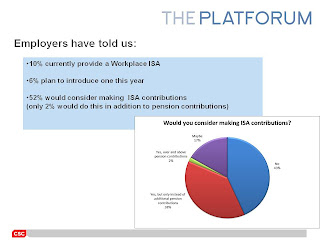I was the token employer speaking at a conference yesterday amongst the great and good from the corporate platform provider market (including AEGON, AVIVA, Friends, L&G, Scottish Widows, Standard Life, Zurich). We were asking ourselves the question -" Is 2013 the year that will make Corporate platforms?" With more platforms being launched in 2012 (9 providers in the market now according to Mercer) and a large amount of money being spent by the industry in this area, did we believe that take up during 2013 was going to meet the expectations of the market. Apparently not was the majority view of the delegates who were predominantley the providers themselves!
My slides showing the CSC case study are below. CSC launched their platform with Scottish Widows in May 2010 and more than 2 years later we are probably best placed to talk about the take up of both the savings (non-pension) products and the usage of the education platform. From a workforce in the UK of 7,000 we currently have 13 employees paying into the internet savings account, 27 to a cash ISA and merely 1 paying to the Equity Funds ISA which we launched over 12 months ago. If any other staff product being offered via our Flex platform had such low levels of take up (pet insurance is a good example) we would remove it from the platform without a second thought, as why bother with all the administration, payroll deductions and communication when only a handful of employees are interested.
There was a lot of talk from Mercer and the other speakers about future-proofing and choosing a platform now so these savings products can be "swithced on" when there is more employee engagement and interest. But will there ever be enthusiasm from employees to take up an ISA being offered by their employer instead of shopping around on the internet to find the best rates/offers/incentives frequently offered by the retail ISA market. Do employees really value the ease of payroll deductions over a direct payment from their bank if they can get a better deal by shopping around.
In relation to repeat visits to the website, again this is really disappointing and over the last 2 years we can show that employees only tend to visit the site when they are encouraged/pushed to do so following communication campaigns which at CSC tend to co-incide with our flex election period in November/December and our finanical product flex election window in March prior to the start of the tax year.
There certainly seems to be a lot of interest from employers. According to recent research from the Platforum 30% to 40% of employers they interviewed with over 1,000 employees intend to review and potentially implement a Corporate platform in the next 24 months. Avivia's research showed 35% of the employers they interviewed were aware of Corporate platforms and were interested in adopting one. However with Auto-enrolment occupying large employers minds and budgets during 2013 it is unlikely that introducing a savings platform is unlikely to be high on the Corporate agenda.
The current ISA market is approximately £350 billion which is about equal to the Corporate DC market estimated at £345 billion, so there is certainly a UK market. However my own opinion is that it is not until a Company is willing to pay matching contributions into any savings product and not just the company pension scheme that any take up of savings products via the employer, rather than directly with a bank or other financial institution, is unlikely to prove popular, as what is the incentive for doing so? Equally until the providers start to make the education that is provided on their platforms relevant to employees using data collated across all of an individuals pensions/savings, and showing "what is in it for them" or "what have people like me benefited from" in case studies, then engagement will continue to be a communication effort that an employer may just not be willing to undertake.
The conclusion from the speaker at the end of the day was that the financial services industry is well behind the retail industry with its use of technology and the engagement from its customers, and that all those in the conference room needed to be collectively accountable for changing that environment if the purchasing of savings products via these Corporate platforms was to become common place. Certainly not in 2013 but is there hope for the future?


























